My Dear Malevich: 3D – Space, Tom Chambers
My Dear Malevich: 3D
Chambers has taken the “black” out of the pieces except for shading and shadows, and what he likes about this Suprematist journey is its origin within a digitized portrait of Malevich magnified to reveal the pixel configurations as 2D representations, and then extruded as 3D representations (sculptures).
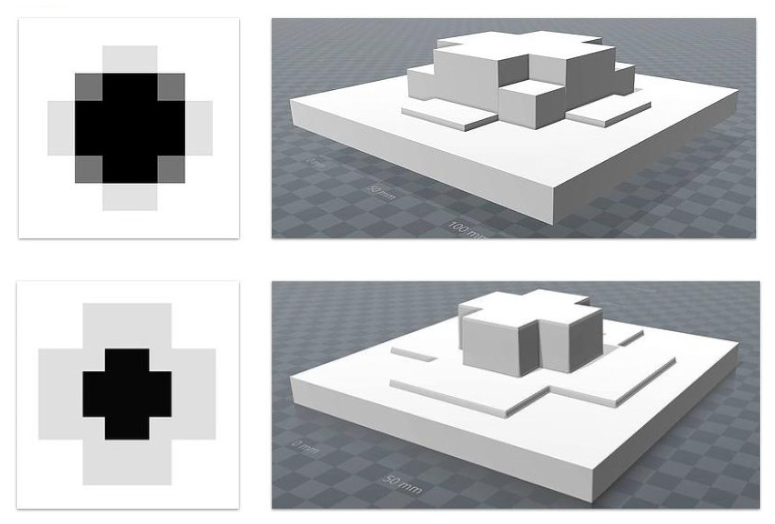
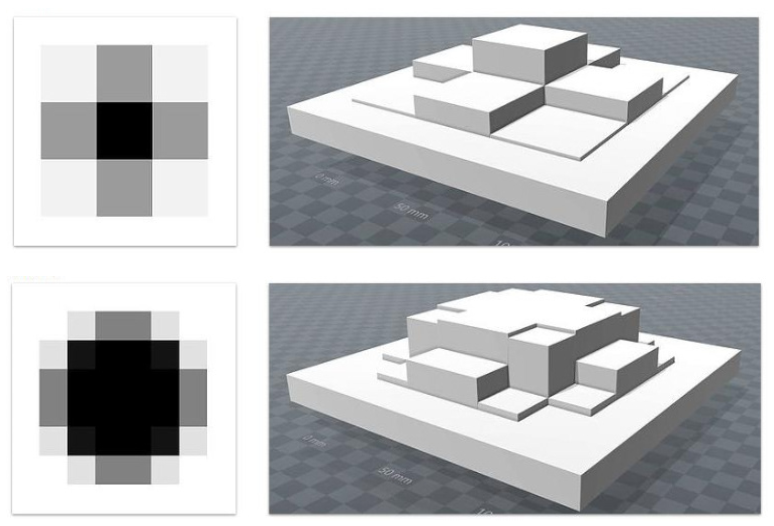
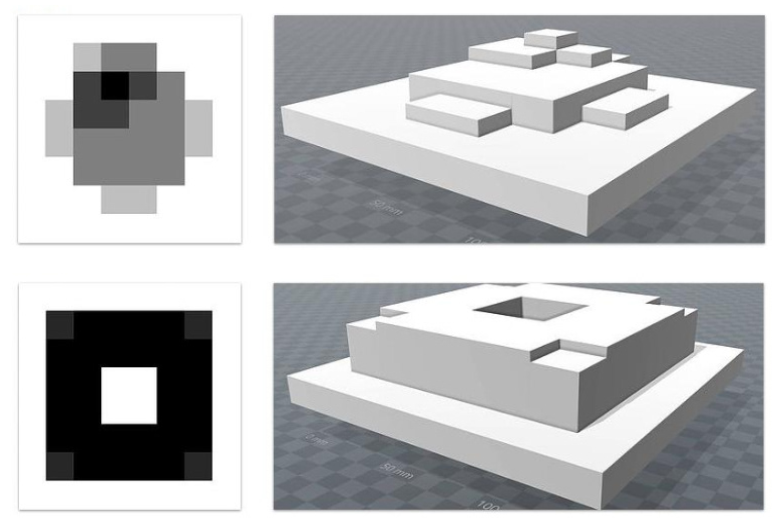
“New architecture is distinguished from Suprematist architecture by the latter and also by the order of elements in Suprematist architecture. This is clearly felt when one compares the two forms of Western new architecture and Suprematist architectonics. The architectonics Alpha of horizontal building and Gota of vertical reveal those features, which, it seems to me, ought to be in the new architecture. Because of its formal similarity contemporary architecture may be divided into characteristic types: individual and collective.
Kazimir Malevich, Painting and the Problem of Architecture, 1928
New architecture, as a form, I attribute to collective elaboration, on which not only architects but also artists who are basically painters are working. The collective of new architecture consists of a large number of people. This latter fact makes me think that our architectural period has even in immediate link with antique architecture, in its methods and even in its attitude to life. In the classical architecture of the past there was also an invariable forming element present, which was worked on by many architects.
They were united by the same objective forming element that we now find in the new Suprematist architecture. Now, as then, with the help of the same forming element which creates an architectural expression of life, the architect is able to reveal his own personality. This latter feature alters neither form nor style but merely produces an individual nuance.”
The pieces (“My Dear Malevich”) (2D) shown in the “Suprematism Infinity: Reflections, Interpretations, Explorations” exhibition (Atrium Gallery, Harriman Institute, Columbia University, New York City, New York [December 10, 2015]; accepted for the Russian American Cultural Center (RACC) Art Collection, New York City) are transformed 3-dimensionally as “ARCHITECTONS” in keeping with Kazimir Malevich’s 3D work.
Chambers exhibited “My Dear Malevich” along with Max Semakov’s “Architecton” models as a part of “Black Square Interpretations and Other Suprematist Explorations”, CaviArt Gallery, Russian Cultural Center, Houston, Texas, March 6 – April 7, 2015. Semakov and his MiMs Art group are inspired by Suprematist architectons transformed into elements of recreational architecture to comprise “Suprematist Park” (project based in Moscow, Russia). These models are displayed in the poster (photographs and design by Chambers) below:
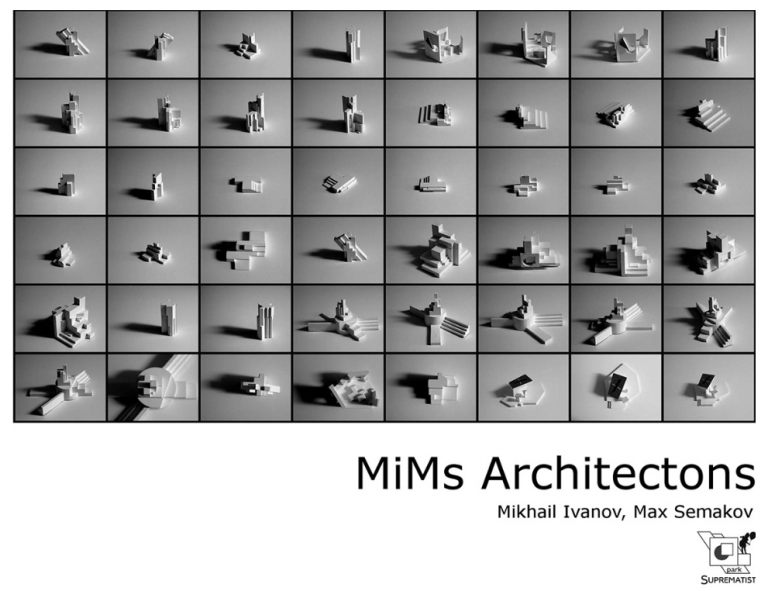
Black square space
Tom R. Chambers utilizes images of the Universe (courtesy of hubblesite.org) in combination with Kazimir Malevich’s “Black Square” to confirm his (Malevich) interest in Astronomy and connection of his Suprematist work with the Universe. The “Space” images have been pixellated to show abstractions – configurations of pixels – running throughout the “Black Square” and beyond (“white abyss”). Malevich’s “Black Square” becomes monolithic/monumental. Malevich called himself, “President of s(S)pace”.

According to “The Cosmos and the Canvas”, Aleksandra Shatskikh, Malevich at Tate Modern, July 30, 2014 (Tate Etc., Issue 31, Summer 2014):
Kazimir Malevich called his abstract compositions Suprematism, which in its first stage meant the dominance of color energy and its transformations in painting. For him, the life of color as such was linked to the Universe: objectless color generated the sensation of its objectless, imageless being. According to him, the “white abyss” of the background, whose whiteness was conditioned by the extreme incandescence of energetic tension in the Universe, was the manifestation of s(S)pace on Suprematist canvases. In late 1917 the painted elements became increasingly dynamic. Their sharp edges cut into the whiteness, and as the concentration of colour decreases, the boundary between figure and background disappears. Malevich called this process “dissolution”, a term with Cosmic connotations: “The Cosmos is dissolution. The Earth is a small splitting.” Through the dissolution of color by the “white abyss” in Suprematism, the phenomenon of non-material time, linked to non-figurative space, appeared more often. In a 1918 poem, Malevich developed this idea:
“Each shape has a real type of time and the coloration of colors is the power of the time’s oscillation, time’s movement creates shape while simultaneously coloring it and consequently the speed of time can be defined by color.”
It was his work on “Victory Over the Sun” that gave rise to his first personal “ism”, Alogical Fevralism. Speaking at a debate in February 1914, Malevich announced that he had “rejected reason”. He was now placing his bets on irrational “sensation”. Freed from objective representations, this would lie at the heart of the new art, Suprematism and, through it, a new world view, and could rest only on phenomena that were purposely not subject to the distorting directives of human reason. He perceived these phenomena in physical manifestations such as electricity, Roentgen rays and gravitation, which were invisible in s(S)pace and time.
In spring 1915 the solar symbolism of “Victory Over the Sun” took on new meaning for Malevich. In addition to its “desconstructivist” (his own term) objectives, the Futurist masterpiece was discovered to have utopian-constructive potential, which he linked to the energetic essence of universal processes and their invisible incorporeal might. He would consider embodying Nature’s true being to be the goal of both his own art and art as a whole.
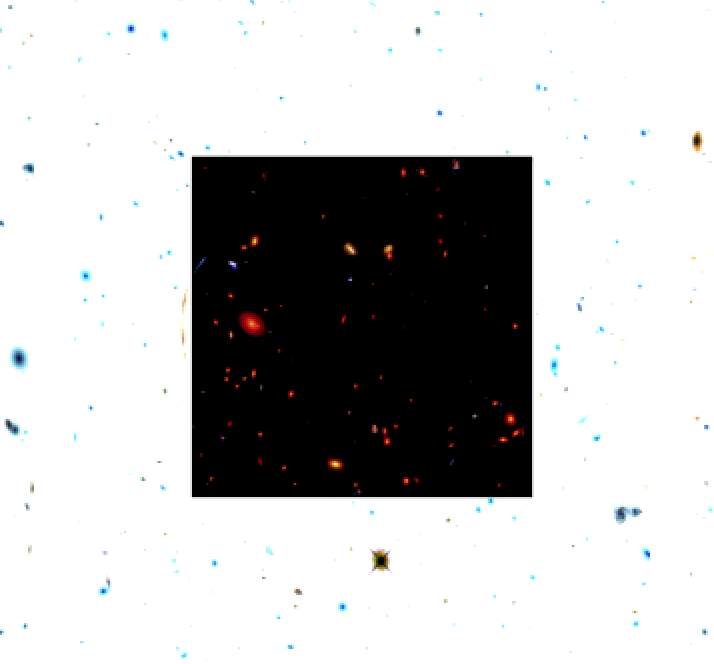
Malevich included the expression “partial eclipse” in his works during his Fevralism period, such as “Composition with Mona Lisa”, 1914. His “Black Square” of 1915 marked the “total eclipse” that had long been maturing in his art. The black rectangular plane definitively crowded out the natural celestial body that had ensured the sensory perception of earthly reality. It shifted its creator to another – purely speculative – dimension. “A system is being constructed in time and s(S)pace; independent of any aesthetic beauties, experiences, moods, rather [it] is a philosophical color system for realizing the new achievements of my ideas as cognition,” Malevich wrote in the preface to a 1919 group exhibition in Moscow. Subsequently, in his theoretical works he expanded several times on the unitary nature of the Universe’s spaces and “the infinite space of the human skull”.
In Malevich’s everyday life, his proclamation of the inevitable break from Earth and speculative mastery of space turned into a passionate immersion in Astronomy. During his Vitebsk years (1919-22), he was never parted from his pocket telescope, constantly observing and studying the starry sky, the map of which he knew thoroughly. This engendered one of his most astounding texts, “Suprematism: 34 Drawings”, published on December 15, 1920 with its prophetic lines in the introduction about humanity’s Cosmic future. It was here that he gave the ordinary word “sputnik” – Russian for companion or fellow traveller – the meaning that made it famous. As we know, “sputnik” has existed in all the world’s languages without translation ever since the call signs of an artificial, man-made celestial body went out on October 4, 1957.
In his text, Malevich lays out visionary ideas of amazing heuristic power, while touching on a sphere seemingly removed from art – technology:
The Suprematist machine, if it can be put that way, will be single-purposed and have no attachments. A bar alloyed with all the elements, like the Earthly sphere, will bear the life of perfections, so that each constructed Suprematist body will be included in Nature’s natural organisation and will form a new sputnik; it is merely a matter of finding the relationship between the two bodies racing in s(S)pace. A new sputnik can be built between Earth and Moon, a Suprematist sputnik equipped with all the elements that moves in an orbit, forming its own new path.
Exhibition:
“Black Square Space” (“Black Square Interpretations”) (article), International Digital Art Gallery (D-ART), 22nd International Conference on Information Visualization and 15th Conference Computer Graphics, Imaging and Visualization, University of Salerno, Salerno, Italy, July 10-13, 2018. Organized in London, England. (https://dart20189.wixsite.com/iv-2018/tom-chambers)
You Might Also Like:
Van Luong (1)
 Kjell Zillen (4)
Kjell Zillen (4) Mels Dees (9)
Mels Dees (9) Gao Yu (4)
Gao Yu (4)Katya Lebedev (1)
Juan Dies (1)
 Anastasia Prahova (2)
Anastasia Prahova (2)Nena Nastasiya (7)
Taarn Scott (6)
 Cynthia Fusillo (20)
Cynthia Fusillo (20)Roberta Orlando (8)
 Nanda Raemansky (25)
Nanda Raemansky (25) Eliane Velozo (22)
Eliane Velozo (22)Leyya Mona Tawil (1)
Julia Dubovyk (2)
Jianglong (2)
 Iara Abreu (23)
Iara Abreu (23) Agathe Simon (1)
Agathe Simon (1)Rosetta Allan (1)
Elizaveta Ostapenko (5)
 Valentin Boiangiu (2)
Valentin Boiangiu (2) Wesley John Fourie (9)
Wesley John Fourie (9) Renato Roque (3)
Renato Roque (3)Rosa Gauditano (5)
Neerajj Mittra (34)
Ciana Fitzgerald (5)
Boris Moz (3)
 Katerina Muravuova (5)
Katerina Muravuova (5)Kyla Bernberg (1)
 Muyuan He (1)
Muyuan He (1)Liza Odinokikh (2)
 Amalia Gil-Merino (2)
Amalia Gil-Merino (2)Paulo Carvalho Ferreira (6)
 Anastasiia Komissarova (2)
Anastasiia Komissarova (2) Yumiko Ono (1)
Yumiko Ono (1) Stefania Smolkina (1)
Stefania Smolkina (1)Lena Adasheva (1)
 Zahar Al-Dabbagh (1)
Zahar Al-Dabbagh (1) Emily Orzech (6)
Emily Orzech (6) Fernanda Olivares (5)
Fernanda Olivares (5) Noor van der Brugge (3)
Noor van der Brugge (3) Ira Papadopoulou (2)
Ira Papadopoulou (2) Tom Chambers (8)
Tom Chambers (8) Titi Gutierrez (3)
Titi Gutierrez (3) Franz Wanner (2)
Franz Wanner (2) Crystal Marshall (6)
Crystal Marshall (6) Transpositions III (36)
Transpositions III (36) Riddhi Patel (3)
Riddhi Patel (3) Michele Kishita (2)
Michele Kishita (2)Damian Carlton (4)
 Deanna Sirlin (1)
Deanna Sirlin (1) Laura Salerno (3)
Laura Salerno (3) Nina Annabelle Märkl (12)
Nina Annabelle Märkl (12) Elina Fattakhova (1)
Elina Fattakhova (1) Tasha Hurley (1)
Tasha Hurley (1) Ian Hartley (2)
Ian Hartley (2) Laurence de Valmy (2)
Laurence de Valmy (2) Ilia Bouslakov (5)
Ilia Bouslakov (5) Andrea Ahuactzin Pintos (4)
Andrea Ahuactzin Pintos (4) Sveta Nosova (3)
Sveta Nosova (3)Carlos Carvalho (1)
 Maria Timofeeva (1)
Maria Timofeeva (1) Jinn Bug (2)
Jinn Bug (2) Johannes Gerard (3)
Johannes Gerard (3)Irène Mélix (1)
 Aba Lluch Dalena (3)
Aba Lluch Dalena (3) Fabian Reimann (1)
Fabian Reimann (1)Natalia Gourova (1)
 Kate Finkelstein (4)
Kate Finkelstein (4)Raina Greifer (1)
James McCann (2)
Naza del Rosal Ortiz (1)
 Jay Critchley Jay Critchley (1)
Jay Critchley Jay Critchley (1) Vicky Clarke (4)
Vicky Clarke (4) Maria Silva (4)
Maria Silva (4) Shir Cohen (5)
Shir Cohen (5) Peter Shenai (4)
Peter Shenai (4) Bo Choy (4)
Bo Choy (4)Alina Orlov (2)
 Olga Popova (3)
Olga Popova (3) Coco Spencer (2)
Coco Spencer (2) Filippo Fabbri (2)
Filippo Fabbri (2)Daniele Leonardo (5)
 SISTERS HOPE (1)
SISTERS HOPE (1) Scenocosme : Gregory Lasserre & Anais met den Ancxt (4)
Scenocosme : Gregory Lasserre & Anais met den Ancxt (4) Anne Fehres & Luke Conroy (6)
Anne Fehres & Luke Conroy (6) Olesya Ilenok (2)
Olesya Ilenok (2) Marie-Eve Levasseur (4)
Marie-Eve Levasseur (4) Natalia Tikhonova (2)
Natalia Tikhonova (2)Ildar Iakubov (1)
 Evgeniy Lukuta (7)
Evgeniy Lukuta (7) Jarkko Räsänen (5)
Jarkko Räsänen (5)Maria Guta (6)
Egle Kulbokaite Dorota Gaweda (6)
Thomas Kotik (1)
 Andrea Stanislav (3)
Andrea Stanislav (3)Ludmila Belova (1)
Alena Levina (1)
 Ilia Symphocat (2)
Ilia Symphocat (2)Yevgeniy Fiks (1)
Star Trauth (18)
Jyoti Arvey (1)
Les Joynes (2)
 Ekaterina Ivanova (1)
Ekaterina Ivanova (1) Lev Shusharichev (1)
Lev Shusharichev (1)Michael Stebackov (5)
Ryan Griffith (3)

